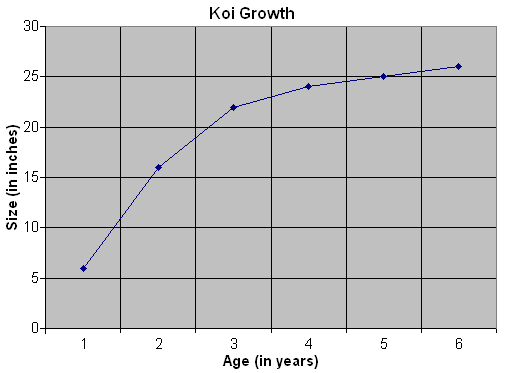| Koi Growth | |
| When people come to Bickal Koi Farm in Toddville Iowa, and I point out some of my 2 year old koi that are a whopping 16" long, the most frequent response I get is "how do you grow your Bickal Koi so fast?". I jokingly answer "Bickal Koi Farm in Toddville Iowa is located 2 miles from a nuclear power plant in Palo Iowa", the real answer to fast koi growth is "Unlimited Food and Fresh Healthy Water". | |
 | |
|
Unlimited Food Do your koi rush up to greet you when you come to feed them? Do they gobble up every last pellet in a frenzy of flopping tails and fins? If your answer is yes, you are probably underfeeding them. How much should my koi be eating you ask? The common rule of thumb for feeding your koi is "Feed as much as they can eat in 5 minutes" or "Feed 2% of their body weight per day". There is a Myth out there that koi can overeat and die, when in reality, the koi are dying because the water gets polluted. At Bickal Koi Farm in Toddville Iowa we feed our koi using a Pendulum Demand Feeder that I purchased from Aquatic-Eco Systems. | |
| The feeder works by the koi tapping a stick that dangles in the water. Each time the stick it tapped it releases a small amount of pellets. The koi feed themselves. It only takes them a few minutes to learn to use the feeder. For the first few days the koi will eat twice the normal amount of food (because they were starving), once they realize the food source is constant, their behavior changes, and they eat at a more regular pace. My koi rarely eat during the day. They start eating around dusk, and eat throughout the night. There is one disadvantage to using a demand feeder - The koi will no longer take pellets by hand. This can be remedied by feeding them treats. Just as table scraps are treats for a dog, feeding a koi watermelon, worms, shrimp, or other goodies, can easily entice them over to eat from your hand. | |
|
Fresh Healthy Water "Do you do weekly water changes on your pond?" The typical answer is "Yes, as water evaporates I re-fill the pond". Well what most people don't realize, is as the water evaporates from your pond, the pollutants stay in the water. I keep tabs on the evaporation rate in Iowa by using this website: http://www.mesonet.agron.iastate.edu/agclimate/display.php?prod=6. On a typical summer day my large pond can evaporate around a quarter inch of water a day which is just over 300 gallons. Koi release pheromones (hormones). As the level of these hormones builds up in the water it triggers a response that tells the koi "stop growing" that the water they are in is over-crowded. A study by Perimutter, Alfred, Daniel Sarot, Man Lin Yu, Rocco Filazzoia and Seely on the Effects of Crowding on the Immune Response of Fish indicates that there are 'other' hidden factors at work than first meet the eye. If the level of hormone is 1ppm (Parts per million) this week, the fresh water will delute it slightly, but the hormone remains, and by next week will be 2ppm. The solution is to pump out at least 10% of your water once a week. Then refill your pond. This way you reduce the pollutants and the koi grow and remain healthy. My waste water goes out to my garden which fertalizes my tomato plants. My garden is on the west downhill side of my yard that has no neighbors so no water can possibly make it to the neighbors yard which is on the east. Neighbors, you know who you are, your yard gets wet when it rains, blame monther nature, not my pond. In 2008 Iowa got 36 inches of rain. On a 1 acre property 1" of rain is 27,000 gallons. You live downhill of 7 acres, do the math! You also live downhill of 5 houses, all of which have septic tanks and leach fields than drain downhill to your property. | |
|
How fast can they grow? Genetics play a large part. I find that koi from pure breed Japanese Stock grow faster than Koi that come from many generation of mixed parentage (mutts). Chagoi, and single color koi tend to grow faster than multi-colored koi as their genetics are closer to the origional carp. Gender can often influence growth. Males typically do not grow as fast or as big. Once female koi reach spawning age, they spend more energy with egg production and dont grow as fast. Based on my own experience, here is the type of growth we typically get from koi that we raise:  | |